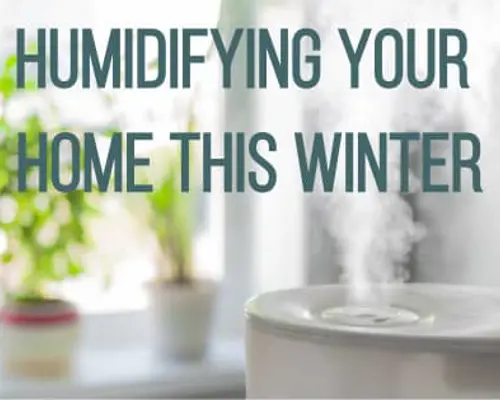
It’s the middle of winter. If the cold air outside didn’t tip you off, maybe your insanely dry indoor air did. Cold outdoor temperatures are notorious for making the air inside your home feel extra dry. Dry indoor air can cause problems for your home and your health!
When the moist air in your home escapes, it is replaced by dry air from outside, which can seriously compromise comfort. That’s why it’s important to amp up the humidity in your home during the coldest months of the year.
In this article, we'll answer some of the most common questions we hear about indoor humidity levels in your home. We’ll also explain the best humidity levels for homes in the winter. Intrigued? Let’s get started.
What Is a Good Humidity Level for Homes in Winter?
Everyone has different preferences, but in general, the best levels of in-home humidity in winter are between 30-40 percent. Any higher relative humidity than this and you may see condensation build up on your windows.
You may be asking yourself, what is relative humidity?
Relative Humidity
Relative humidity is the amount of water vapor present in the air in relation to the amount of water vapor the air can hold. This is always expressed as a percentage.
Let’s say, for example, you had a reading of 100 percent relative humidity. That would mean the air is completely saturated with water vapor and cannot hold any more moisture at that temperature.
Warm air can hold more water vapor than cold air, so you may notice more humidity in the air during the cold winter months when your thermostat is cranked up high.
How Do I Add Humidity to a Room in Winter?
When temperatures cool down, our usual response is to turn up the heat. But artificial heat from your furnace can leave your home feeling as dry as a desert.
Humidity plays a key role in keeping you comfortable in your home. Extremely dry air can cause health problems as well as issues with your home’s structure and decor. Low humidity can result in:
-
Chapped, dry skin
-
Inflamed allergies
-
Itchy eyes
-
Nosebleeds
-
Increased amounts of static shock
-
Cracked paint
-
Peeling wallpaper
-
Warped wooden floors
During extreme weather like the winter or summer, you may need to find ways to increase the humidity levels in your home. You can keep your air conditioner or heater on as usual, but adding some moisture to the air can ensure you have the perfect home air with these simple tips.
1. Get Some Houseplants
If you have a very dry-air home, start by considering plants. Through the process of transpiration, plants pull water up through their roots to their stems, leaves, and flowers. From there, it evaporates, adding much-needed moisture to your indoor air.
Get several plants at a time and put them in the same area. This will create a humid micro-climate that keeps the room from drying out and makes your air more humid.
Houseplants not only humidify the indoor air around them—they purify it too! Plants with the highest transpiration rates remove the most airborne pollutants, making your home safe and cleaner.
2. Spread Some Steam with Your Home Appliances
Some of the easiest ways to humidify your home involve household tasks that you perform daily. Steam from the hot water you regularly use will mix with the dry air in your home to make it more humid.
To take advantage of appliances that produce steam:
-
Crack open the bathroom door when you shower, or let your bathwater cool before you empty the tub.
-
After bathing, turn on your bathroom fan to help push damp air out and into nearby rooms.
-
Skip the drying cycle on your dishwasher, leave the door open, and let your dishes air-dry.
3. Air-Dry Your Laundry Indoors
Just like your furnace, your laundry dryer robs your indoor air of moisture. To increase the humidity in your home, let your dryer take a break.
Hang a few clotheslines around the house where you can air-dry your clean laundry. Your damp clothes will add humidity to the air as they dry while simultaneously saving energy!
Just make sure to hang your clothes in areas with adequate airflow to prevent mold and mildew from forming on them.
4. Adopt Some Fishy Friends
If you love pets, consider adopting a few fish. Adding a fish tank to a room with especially dry air is a great way to add humidity. Evaporated air will rise into surrounding areas while the fish tank enhances your home décor.
Make sure your fish tank has an open top, and remember to keep it full of fresh water to prevent bad odors and mold spores from forming. Keep in mind that maintaining a fish tank requires lots of time, space, and expense, but the benefits of comfortable humid air are priceless.
You can achieve the same results on a smaller scale with a fishbowl placed near heat sources in your home.
5. Invest in a Whole-Home Humidifier
The most effective way to combat dry indoor air is to invest in a whole-home humidifier.
Installed directly onto your existing HVAC system, a whole-home humidifier infuses humidity into your indoor air by distributing water vapor through your home’s ducts and vents. As their name suggests, whole-home humidifiers add moisture to all the rooms in your home, unlike portable humidifiers, which only add moisture to the room in which they are located.
Whole-home humidifiers only require one filter change per year, demanding much less maintenance than portable humidifiers, which need to be regularly cleaned and disinfected.
Installing a new whole-home humidifier is easy when you choose American Residential Services. We can get you the right system and install it quickly at a competitive cost.
Call us today and schedule your humidifier installation now!
What Happens if It Gets Too Humid?
While some people work hard to add humidity to their air, you may have the opposite problem. Too much humidity can cause problems as well.
Your home’s humidity level may be too high if you find condensation on your windows around the house. While this may not seem like a big problem at first, if this happens too often, condensation on the windows can eventually bead up, roll down, and soak into the window frame.
If your humidity stays high throughout the winter months, this water can leak back behind the wall below the window, leading to wood rot and mold. Not only is mold dangerous for your family in the home, but water damage in your walls, floors, and ceiling can get expensive.
How Do I Reduce the Humidity in My House?
When you start to see condensation on your windows, you need to make some changes. Start by adjusting your whole-home humidifier so your humidity level is lower. This will fix the problem, and you should see results shortly. If you don’t, have an HVAC specialist come to examine your whole-house humidifier.
Call American Residential Services. We can come and make sure your whole-home humidifier is working properly, or replace it if necessary.
If you don’t have a whole-home humidifier, there are many other ways to bring low humidity levels back into your home:
-
Take cooler showers or baths to reduce the amount of steam released in your home.
-
Let your dishwasher cool off before opening it to avoid releasing steam.
-
Use your exhaust/ventilation fans to prevent moist air buildup in any one area.
-
Use your laundry dryer less often and make sure the dryer vents aren’t blocked or clogged.
-
Purchase a dehumidifier and place it in the room with the highest humidity to remove water from the air.
-
Open windows occasionally when weather permits.
-
Install vapor barriers in windows or in your crawl space so the environment around your home can’t let moisture in.
If those steps don’t help reduce the humidity, you might consider a dehumidifier. You can learn more about the signs you heed a dehumidifier here. These little changes in your home can give some relief from high humidity and keep your home safe from water damage.
Take Control of Your Indoor Humidity in Winter
Perfect indoor air is achievable! Maintain the best humidity levels when you add a whole-home humidifier to your HVAC system.
Contact your local ARS®/Rescue Rooter® today by calling 866-399-2885 to schedule an appointment with one of our Comfort Advisors. We’ll assess your indoor air quality and guide you through our whole-home humidifier products and services, all of which are always covered by our Exceptional Service Guarantee.
Stop letting dry indoor air compromise your comfort. Take the step today to make your home comfortable all year long!






